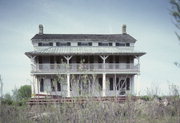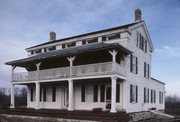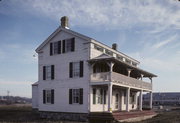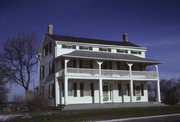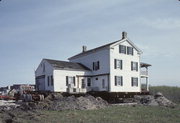Property Record
1075 N PILGRIM PARKWAY
Architecture and History Inventory
| Historic Name: | DOUSMAN INN |
|---|---|
| Other Name: | The Dousman Stagecoach Inn Museum |
| Contributing: | |
| Reference Number: | 7767 |
| Location (Address): | 1075 N PILGRIM PARKWAY |
|---|---|
| County: | Waukesha |
| City: | Brookfield |
| Township/Village: | |
| Unincorporated Community: | |
| Town: | |
| Range: | |
| Direction: | |
| Section: | |
| Quarter Section: | |
| Quarter/Quarter Section: |
| Year Built: | 1848 |
|---|---|
| Additions: | 1855 |
| Survey Date: | 1993 |
| Historic Use: | inn |
| Architectural Style: | Greek Revival |
| Structural System: | Balloon Frame |
| Wall Material: | Clapboard |
| Architect: | |
| Other Buildings On Site: | |
| Demolished?: | No |
| Demolished Date: |
| National/State Register Listing Name: | Dousman Inn |
|---|---|
| National Register Listing Date: | 1/15/1979 |
| State Register Listing Date: | 1/1/1989 |
| National Register Multiple Property Name: |
| Additional Information: | A 'site file' exists for this property. It contains additional information such as correspondence, newspaper clippings, or historical information. It is a public record and may be viewed in person at the Wisconsin Historical Society, Division of Historic Preservation. HABS WI-28-2. FRONT PORCH APPEARS TO HAVE BEEN MODIFIED. HAS A WAUKESHA CO. HISTORICAL MARKER WHICH STATES THAT THE BUILDING WAS CONSTRUCTED FOR MICHAEL DOUSMAN, A FUR TRADER. IN 1884, CHARLES DUNKEL PURCHASED THE HOUSE AND IT BECAME KNOWN AS THE DUNKEL INN, OR HALFWAY HOUSE. JOHN BEHLING RESTORED THE HOUSE IN 1962. WAS THE FIRST FARM TO BE SCIENTIFICALLY OPERATED IN THE STATE. THERE WERE 90 ACRES OF CROPS AND A TROUT HATCHERY. AS OF 1978 THE FARM WAS USED TO RAISE POULTRY. MOVED TO CURRENT LOCATION IN 1981. ORIGINAL LOCATION WAS 15670 W. BLUE MOUND RD. DESCRIPTION: This building is a two and one half story frame Greek Revival building with a single story frame wing. In appearance the inn is similar to other ante-bellum stage coach inns in Wisconsin. The main (south) facade of the inn contains five bays symmetrically arranged. On the first floor a doorway with sidelights, framed by a heavy lintel and pilasters, is flanked by two windows on the west side and a window and a door on the east side. The second story configuration is similar, although moldings around the doorway are plain. The attic story is lit by five windows in the frieze. The majority of windows are shuttered, and with the exception of the frieze windows which are side-by-side paris of panes, all windows are double-hung with six-over-six lights. A two story porch as been reconstructed across the main facade. Square single-story pilasters, four on each level, support the porch and its roof. The sides or gable ends of the building are similar. Each contains six windows, two on each story, those on the attic sotry being closer together than the others. Chimneys are inside of the walls in the gable ends. On the east side of the rear of the building is a story and a half kitchen wing. Its fireplace and/or chimney have been removed. Both the main portion and the kitchen wing are of post and beam construction, joined by mortise and tenon. Framing members are large hewn timbers of red oak, black walnut and pine. The interior of the building has been altered somewhat, although the original plan remains as do most original moldings, doors and a good deal of the original plaster-work. The main floor is arranged traditionally, with a central stairway and a hall flanked with two rooms on each side. The original staircase, rail, and newel post remain. The attic is virtually unaltered from the time it served as the inn's ballroom. It is not partioned, and built-in benches line the north and south walls. Related buildings include a fieldstone shed, a wooden greenhouse and a cut stone and wooden barn. ARCHITECTURAL/ENGINEERING SIGNIFICANCE: This building is an excellent example of a distinctive type and style of building, namely a vernacular Greek Revival Stagecoach Inn, characterized as a two-and-one-half or three-story frame structure with a five-bay facade, a large porch sometimes two stories high, and central doorways usually on both the first ans second stories. This building ranks with the Wade House in Sheboygan County as a well-preserved example of the vanishing type. Identified in 1934 by the Historic American Buildings Survey as an outsanding piece of architecture in the Wisconsin frontier context, the Inn exhibits the cornice returns, frieze with attic windows, pilasters, Greek Revival doorway, plan and interior woodwork which identify it as an excellent example of the Greek Revival as interpreted in Wisconsin. HISTORICAL BACKGROUND: This inn was built by the Dousman family at the historic intersection of the Blue Mound Military Road and the Watertown Plank Road, both important arteries of migration into the interior of Wisconsin. During the heyday of the Inn, a major portion of American westward migration followed the Great Lakes route, disembarking at Milwaukee and Chicago. The Dousman Inn, situated a half-days travel west of Milwaukee became, in the 1840s and 1850s, an important stopping place. The Inn was constructed on the north side of the military road in the 1840s. A flurry of land transactions in 1843, when the Inn site changed hands twice and the value of the property incresed to $1,500, suggests that the Inn was built in that year. Local tradition has it that Michael Dousman owned the Inn until his death in 1854. A prominent businessman, he lived in Mackinack, but speculated extensively in real estate and development schemes in Wisconsin and Milwaukee in particular. The farm and Inn in Brookfield represented only a fraction of Dousman's enterprises in the Milwaukee area, and he visited the city at frequent intervals. His sons George D., Talbot C., and Hercules L., became influential figures in the development of Wisconsin. It is unknown whether any of the Dousmans actually resided in or operated the Inn. After Michael Dousman's death, the Dousman heirs sold the Inn and the adjoining Dousman farm to Daniel Brown, a Yankee who had come to Brookfield several years before. Brown worked the farm and opeated the Inn, which has known locally as The Dousman. Along the road passed large numbers of the immigrants who would people the interior of Wisconsin, many of them stopping for rest, refreshment and conviviality at Brown's inn. Nevertheless, the glory days of the inn would be short, for even during Brown's purchase, the Milwaukee and Waterown Railroad was rendering the difficult-to maintain Watertown Plank Road obsolete. By the time that Brown sold the inn to Frederick Zimdar in 1873, railroads had long since supplanted toll roads like the Watertown Plank Road as primary transportation arteries. The many deed and mortgages pertaining to this ownership tell the frustrated tale of Zimdar's vain attempts, over fourteen years, to gain clear title to the property. In 1884, Zimdar's son conveyed the property to Charles Dunkel. Dunkel converted the inn to a farmhouse but frequently held dances and other social events in the third-floor ballroom. John Behling, Dunkel's grandson, was the last resident of the house, selling it in 1980. Scheduled for demolition, the Inn was saved by the newly-formed Elmbrook Historical Society, and moved four-tenths of a mile north on Pilgrim Parkway to its present location. Covenant/Easement: From 12/4/1981 to 12/4/1991. A 'covenant file' exists for this property. It may contain additional information such as photos, drawings and correspondence. It is a public record and may be viewed in person at the Wisconsin Historical Society, State Historic Preservation Office. |
|---|---|
| Bibliographic References: | PERRIN, RICHARD, HISTORIC WISCONSIN ARCHITECTURE, P. 19 (1976). PERRIN, RICHARD, THE ARCHITECTURE OF WISCONSIN, P. 67 (1967). HISTORIC LANDMARK TOURS BOOK. WAUKESHA FREEMAN 6/5/1996. National Register Form, prepared by the State Historical Society of Wisconsin. Questers, "Historic Landmark Tour," 1991. Milwaukee Journal 7/5/1992. Waukesha Freeman 8/9/2000. Perrin, Richard W. E., Historic Wisconsin Architecture, First Revised Edition (Milwaukee, 1976). |
| Wisconsin Architecture and History Inventory, State Historic Preservation Office, Wisconsin Historical Society, Madison, Wisconsin |

